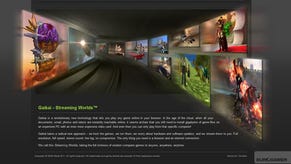Gaikai: Cloud Computing Gameplay That Works?
Eurogamer versus gaming over IP: round two.
Is this the most low-key debut for a new gaming system yet seen? On Wednesday, Gaikai's David Perry posted a video of the first in-game action of his company's "Cloud" computing gameplay system. No hype, no fanfare: just one man, his PC, a wireless headset and a copy of FRAPS. No claims of one millisecond hardware video encoders, no talk of seven years of "stealth development", just a transparent demo captured at Casa de Perry of a streaming gameplay system that seemingly just... works. Amongst other things, it showed World of Warcraft and Super Mario Kart running in a common or garden browser with no plug-ins required. I think it looks authentic, it looks like it might work.
That might surprise a lot of people, bearing in mind that it was my Eurogamer article on how OnLive can't possibly work that juxtaposed the cold hard facts of technological reality with the quite extraordinary claims being made by the OnLive people about streaming gameplay video. But it's important to factor in the notion that the feature was equally explicit about the ways and means in which such a system could potentially stream gameplay over IP. It wouldn't be half as flashy or as awe-inspiring as the OnLive people would seemingly want it to be, but it would work and it could be very cool. The question is, what would you do with it?
Looking at Perry's Gaikai video, it was somewhat reassuring to see that my take on the reality of such a system somewhat vindicated. Gaikai looks authentic because it isn't a state of the art replacement for our PS3s or Xbox 360s in the way that OnLive aspires to be. It's not about getting a mini-box into your living room that supplants console hardware now and forever. Curious to know more, I got in contact with Gaikai directly and fished about for an interview. But in the meantime, I took another look at David Perry's video debut for the Gaikai system, made some annotations and put together this new version of the original video, complete with technical analysis.
What struck me about the presentation was that there was absolutely nothing unbelievable in it whatsoever. There were no claims of streaming 720p gameplay at 60 frames per second - games were running in differently sized windows according to how difficult they were to compress, and video itself runs at the internet standard 30FPS.
There was no talk of world-beating compression systems that annihilate the work of the best minds in video encoding today, the demo was using the exact same h264 codec that we use in the Eurogamer TV Flash player. And finally, there was nothing here to suggest that we were looking at a technological breakthrough that would make our PS3s and Xbox 360s obsolete... just that this was a brand new way to play games in an ultra-accessible manner. Fire up your browser and you're on your way.
Not that there weren't questions of course. No-one appears convinced by the notion that we can play games in real time over the internet with no noticeable lag as both Gaikai and OnLive believe to be possible. Secondly, the idea that this would play anywhere without any kind of plug-in also didn't sit right - surely we'd be talking about custom code here just to get a picture on-screen at all? And finally the "as is" presentation of the video was great, but meant we learned nothing about the ethos behind the whole project and what it was actually setting out to achieve.
Gaikai's David Perry told me that the low-key strategy for the reveal was in part down to our reaction to the glitzy OnLive presentation. Their aim was quite literally to keep it real, hence the FRAPS video approach for the public "unveiling". A similar policy of transparency was used for the E3 demos too.
"There are two ways to do smoke and mirrors," Perry tells me. "I can put a server at the end of your street, or set up in the local datacentre within a mile of your house and do a demo from that, or I can do what OnLive did and pay for a whole bunch of custom cables to be brought into the convention centre that aren't part of the normal infrastructure and we could do it that way... One of the things we needed to get past at E3 was that it would only run on super-fast PCs. So between us all, Rui [Pereira, Gaikai co-founder] had the worst laptop we had - a little Netbook that was running WiFi. What we wanted was for publisher to see two things. First that we can run on that hardware. Secondly the Wi-Fi at E3 was outrageously bad because of all of the wireless traffic going on. If they could play on that little laptop in those conditions, that should put the whole issue to rest."
So, let's talk latency. I have to admit that since the OnLive piece debuted my hardline approach to what is and isn't possible has softened somewhat. On the Digital Foundry blog, I sometimes make mention of Mick West's piece on measuring game latency and I'm currently working on a follow-up feature to that. The work I've done already validates all of West's results. When you see that games like Halo already run with a local lag of 133ms, you get the idea that players are already conditioned to a certain level of responsiveness - or rather unresponsiveness - in their games. "That's a great article to read," says Perry. "It's one of the best articles we've seen. The game itself is where the big delay is."
It's important to point out though that Gaikai/OnLive can't reduce that lag, they will always be adding to it. However, in theory the difference could be less pronounced than the difference in controller response between Halo 3 and Killzone 2, which can be around 33ms in the Bungie game's favour.
Over and above that, for me, the issue now is all about quality of service. The internet is in a state of flux, with constantly changing conditions. While I'm coming around to the notion that the lag question can be resolved, the challenge is in maintaining the consistency of the connection. The fact is we live in a world where a Skype call can drop at any time, and where even on my 8MB ADSL line, sometimes I can't even stream a medium-quality YouTube vid.
"The reality is they're two different kinds of things," says Perry. "One is voice-over-IP. If I'm talking to someone in New York the communications are going all the way across the country. In YouTube's case, it's creating this mega-service infrastructure in some big building somewhere that's trying to get across to us. Our system is all about putting the servers close to the users."
















